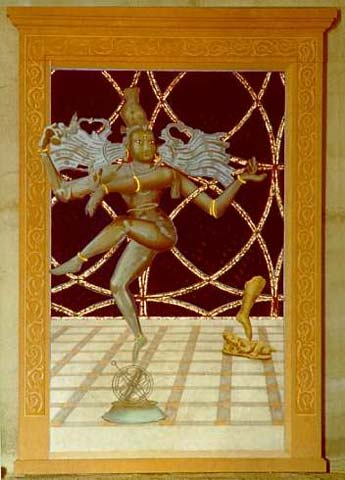
«
Dana for Nataraja »
A votive installation at Palazzo Ducci del Rosso Sansepolcro, Italy
«Dana
for Nataraja » is a pictorial installation that can be located
in that wide fluxus of thought that is at the origin of Ritual Art
in its aspect of devotional or votive paintings.
The structure of the votive cycle has always been formed by three
elements, Donor, Donee, and the offerings through which the ritual
act is performed
«
Curiosity in the Oriental Antique collector's room ». Fresco with
set-in stones and gold leaf. 160x240x5 cms. «Curiosity in the Oriental
Antique collector's room » is a trompe l'oeil showing a view of a
interior with a large statue of Shiva Nataraja, the "King of Dancers".
It is impossible to say the number of dances Shiva taught his worshippers
but we shall talk of just one known as 'Nadanta' which takes place
in the golden hall at Chidambaram or Tillai, the centre of the Universe.
Nadanta is the dance of the Universe: the unceasing flow of energy
that crosses an infinite variety of configurations, each based one
upon the other. In 'Curiosity in the Oriental Antique Collector's
room' Nataraja is shown in his aspect as the Lord of the Universe
and dances on that which, in Western tradition, symbolises the universe,
the armillary sphere. In traditional images Nataraja is represented
dancing on the prostrate body of the demon dwarf called Muyalaka (forgetfullness
or inattentiveness) and symbolizes the blindness of life and man's
ignorance. Victory over this demon consists of attaining true wisdom,
in which one is free of the ties of the world and, in our collector's
room, to represent the age we live in, only a fragment of the foot
that dances over the demon is present . .
Functions
defining the net of the votive act may change in time in the same
way that meanings may be modified and relationships established but
the essence is a unique, simple mechanism, based on the magical protective
or propitiatory power of the principle of resemblance, proximity,
or contact.
In
this ambit it happens that the Donor often has himself portrayed along
with the divinity to which the work is dedicated. For example, in
the spring of 1451, Piero della Francesca was commissioned to paint,
in the Malatestian temple at Rimini, the scene commemorating the consecration
of this imposing dynastic and religious monument. In his fresco Piero
represented his donor, Sigismondo Malatesta, in the act of receiving
a dynastic investiture from his omonymus saint.
Bearing in mind that the essence of votive art is always of a magical
nature, that means based on associations of a « sympathetic » nature,
it is not so difficult to understand the circumstance in which the
Donor has himself portrayed in the clothes of the donee as in the
piece that Matthias Grunewald painted for the Archbishop of the town
of Halle, Albrecht von Brandenburg, where he is portrayed in Saint
Erasmus's clothes. Archbishop von Brandenburg not only professed himself
to be a faithful Erasmian, but also probably hoped to acquire, by
the magical use of this symbol, some of the real Erasmian values.
It
is hard to imagine finding a Donor wishing to do this nowadays, but
indeed the fascination of the ritual act still continues, and in the
autonomous and pathless territory of art, there is still the possibility
of evoking it.
![]()